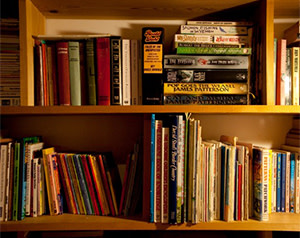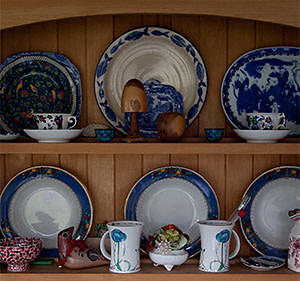DNA pioneer Professor Sir Edwin Southern on the future of genomics

Simply sign up to the Life & Arts myFT Digest -- delivered directly to your inbox.
A knock at the cottage door yields no answer. A light is on, but nobody seems to be home. Down in the valley, I catch sight of a flat-capped, blue-anoraked figure, spade in hand. Is that the world-renowned biochemist I’ve come to meet, or the local farmer?
Professor Sir Edwin Southern waves and makes his way up the muddy track. “I have a bit of a tree thing,” he says, gesturing towards the native trees that he has planted in this quietly beautiful, but by his reckoning under-wooded, corner of the Scottish Borders.
We stoop to enter the long, low cottage where Southern and his partner, Sonia, retreat from their busy lives in Oxfordshire. Slate-roofed and with small-windows, he thinks it was originally an early 19th-century shepherd’s bothy. Back then, three-quarters of the building would have been the winter home for livestock, with just one small room at the end for the shepherd. When Southern bought the place in the mid-1980s, it was used as a chicken shed, and it was he who rolled up his sleeves and dug out the chicken droppings, before setting to work on the extensive renovations that make it the appealingly simple living space it is today.
This immersive approach to problem solving is typical of Southern. He has devoted most of his scientific career to one of the biggest problems in biology: understanding the structure and function of DNA. Modest as always, he thinks it is his dogged determination that has led to his greatest successes in the lab. “I’m not particularly bright, but I’m obsessive,” he says, and yet his proven ability to make innovative leaps in biochemistry and genetics and to translate them into solutions to real world problems suggests more than hard work and bloody mindedness.
Born and raised in a council house in Burnley, Lancashire, with “a cotton mill at one end of the street and a workhouse at the other”, Southern was the first of his family to go to university. The roots of his unusual blend of curiosity, inventiveness and commercial realism can be spotted in his early upbringing. As a child, he was free to explore the town and surrounding countryside. His father, a repairer of typewriters, invented his own work tools and gave his son free rein to tinker and experiment in his workshop. Several other members of his family ran their own businesses, from locksmiths and laundries to timber merchants, providing exposure to the world of business.

Southern has long been aware of the importance of commercialising his inventions, but his main incentive is not one of personal financial gain. There is nothing extravagant in the fabric and decoration of his cottage. A wood stove on a stone hearth warms the living room, bright paintings in reproduction decorate the unplastered stone walls, and an antique Irish pine press houses the crockery.
Southern’s commercial awareness is pragmatic. “If you think your discovery can be useful, it is likely that the commercial sector will be needed to develop and promote it,” he says. He bemoans the lack of risk capital for new ventures and senses a “slight snobbishness” among some academic colleagues, both of which are slowing the pace of technology transfer in the UK. Yet despite overcoming these hurdles himself, for a few years Southern had a rough ride in the commercial sector.
Following licence infringements by a large US biotech company, Southern spent much of the late 1990s fighting a series of exhausting legal battles to protect one of his most important inventions: the microarray, a revolutionary device consisting of thousands of short fragments of DNA arranged on a tiny silicon chip, for studying gene sequences and their functions. He eventually regained control of his intellectual property and with the settlement and licensing income he was able to put his own company, Oxford Gene Technology, on a solid financial footing. Since then, the microarray has been properly developed and has contributed to the emergence of an important branch of scientific inquiry: genomics.

Southern’s microarrays have allowed scientists to examine the status of every single one of our 30,000-odd genes, rapidly and in parallel. This has been a huge step forward for basic researchers and clinicians alike and, together with more recent technology, has led some genomic scientists to predict a healthcare revolution.
Some claim that genomics will allow complex diseases to be understood and diagnosed in unprecedented detail, genetic risk factors to be precisely catalogued, and medical treatments to be tailored to the individual patient’s unique physiology and history. Southern strikes a more cautionary note. “We are generating huge amounts of data, but it is not at all clear whether we are doing the right things with it, let alone how it will be integrated into the healthcare system.” Furthermore, he asks: “Do you really want to know exactly when you will start to develop dementia, when there is still little that can be done to reverse its progression?”
As Southern talks, we move into a space far removed from the high-tech world that he works in. Through the small galley kitchen is the conservatory that Southern has added to the cottage. The cherry and rowan trees just outside the large windows are full of small birds; beyond them stretches an expanse of sky and valley. With its slate floor and comfortable chairs this is a space to read, think and survey the world outside – and not, Southern says, a place to work.

Nevertheless, there is a sense that once Southern gets his teeth into a project, he lives with it wherever he is. In recent years, he has found a new set of problems to tussle with by establishing two charitable trusts. These are the Edina Trust, which promotes science education in UK primary schools and is mainly run by Sonia, and the larger Kirkhouse Trust.
Southern’s original plan for the Kirkhouse Trust was to use his expertise to establish a medical research charity. But with the encouragement of his friend, the Nobel Prize winner Sir Paul Nurse, he set off in a completely fresh direction. “Back then I didn’t have the faintest idea about crop breeding, and Paul said, ‘that’s exactly why you should work on it’,” Southern recalls.
Now in its 14th year, the Kirkhouse Trust uses the latest science to develop new crop strains to help subsistence farmers in the developing world. Focusing mainly on legumes and with most of its activities in east and west sub-Saharan Africa, Southern’s projects are already yielding bean plants with resistance to common diseases and parasites that routinely decimate yields. By helping to set up small genetic testing labs and breeding programmes in parts of the world where there has previously been no molecular biology carried out at all, Southern is also equipping communities with the skills and wherewithal to continue the work that the trust has begun.
This is science at its most applied. The trust’s work is helping to put food on to the plates of some of the world’s hungriest people. Once again, Southern’s creative problem-solving mind and pragmatic approach have come up trumps.
I leave Southern musing on a more local problem. Last year, he carved out terraces and planted rows of fruit trees on the steep, rubbly and non-productive bank outside the cottage. Now he is concerned that the soil needs to be further stabilised. His approach involves systematically monitoring the climatic conditions, acidifying patches of soil, and finding new ways to clonally propagate heathland plants such as bilberry and lingonberry. Maybe if I visit again in a couple of years the fruit trees will be cropping heavily.
——————————————-

Favourite things
From a cupboard that he built himself, Southern produces a well-worn set of carpentry tools – a chisel, a plane, a gauge and a mallet – which he arranges on a table alongside his iPhone. Despite the international respect, money earned and intellectual rewards accrued during more than five decades in science, Southern means it when he says: “I’d have loved to have been a craftsman.”
Comments